
MARS DUST DEVILS & MORE
Report #176
December 27, 2009
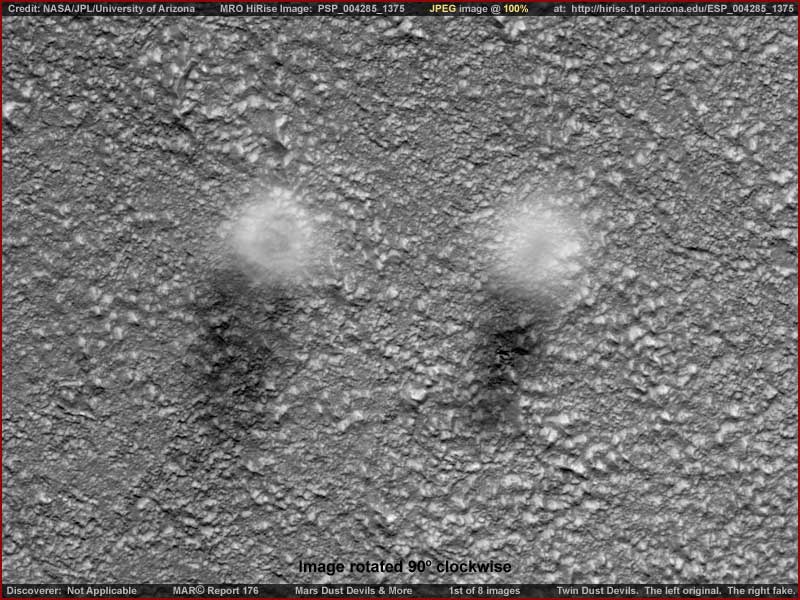
http://hirise.lpl.arizona.edu/PSP_004285_1375
The above 1st image demonstrates two
side-by-side objects in the Mars terrain. This kind of evidence is always
officially identified as dust devils which of course reinforces the official
mantra that Mars is a dry as dust and essentially dead world.
Some of them may very well be dust devils just as they are here on Earth.
However, although dust devils can be found in a large number of areas here
on Earth, remember that Earth is a world 70% covered by water making it essentially
a water world and the exact opposite of dry. So remember that dust devils
on Mars, just as on Earth, do not necessarily indicate a dry as dust world.
Some of these objects labeled as dust devils on Mars may also be water geysers
because they look very similar. However, an admission of that might carry
a suggestion that there could be real surface water presence on Mars, at least
in the form of water geysers. That of course would not be desirable to a secrecy
crowd now would it. That is no doubt why the first water geyser on Mars discovered
in the 1970s Viking imaging by one of NASA's own Dr. Leonard J. Martin of
Lowell Observatory in Flagstaff, Arizona, a well respected and reputable mainstream
planetary scientist, was formally acknowledged as water in the official NASA
record but then was down played immediately thereafter by NASA and JPL. Note
my 2003 on this.
On the other hand, on a whole world with a supposedly super dry surface, you
might anticipate a lot of dust devils to be present. Sure enough along and
along fairly plentiful dust devil presence is fed to us like the above. Also,
just about every dark streak found in the Mars terrain, and there are a great
multitude of them, is identified as the many trails of past dust devils regardless
of what they may truly represent. It was even in the news recently indicating
that scientist were generally agreed on this.
The only trouble is that air vortexes strong enough to create dust devils
large enough to be seen in distant Mars satellite imaging by definition should
leave a mark of their passing on the ground just as is claimed made the great
multitude of dark streaks on Mars. Yet, very little of the evidence demonstrates
this as the dust devil is in operation just as you see above.
Remember that the strong sunlight reflectivity you see in the above objects
in order to be dust devils would be sunlight reflectivity off of dust and
soil picked up off the ground by the vortex since the air itself is transparent.
That degree of reflectivity means that the ground must be disturbed by a dust
devil's passing fueling that reflectivity leaving a mark on the ground as
to its path. So, if there is no mark left in the terrain, are they really
water geysers being purposely misidentified as dust devils?
The answer is sometimes but not necessarily in other cases like this one.
If the image resolution is decent enough to allow it to be seen, a water geyser
pouring out of the ground and in the act of dumping water should have it pile
up on the ground around its base and/or on the ground down wind from its point
of origin. That piling up of water effect should at least leave a dark stain
and/or even stronger sunlight reflectivity on the ground that we can detect
and this is even more true in the MRO HiRISE large JP2 imaging with its theoretically
more detailed views.
The bottom line is that, if the dark streak or otherwise disturbed ground
identifying the path of the dust devils is not there and the water presence
around the base of the geyser is also not there, then what is going on? That
brings us back to the evidence in the above image demonstrating the side-by-side
view of two of these objects officially identified as dust devil. Note my
use the "dust devil" description as singular rather than plural.
That's because I created the dust devil on the right. It was easy to do and
it is most definitely a fake.
It took me only a few minutes in PhotoShop to figure this out and do it using
dark and light smudge mimicking the original on the left even though I have
never done this before and I am not remotely skilled at this sort of thing.
The one on the right is my first attempt at such a fake and, if we measure
looks by the original one on the left, then the fake is clearly a good one.
Let's face it, if I had not identified it as a fake or labeled the image as
such, few would have known the difference except to perhaps be suspicious
of and question how two air vortexes could exist so close together at the
same time.
However, the most likely truth here in the MRO strip is that there are two
fakes here. The one on the right is admittedly mine but the original officially
sanctioned "dust devil" on the left is also almost certainly a official
fake. In fact, in my opinion, there are actually no dust devils or water geysers
present in this terrain at all.
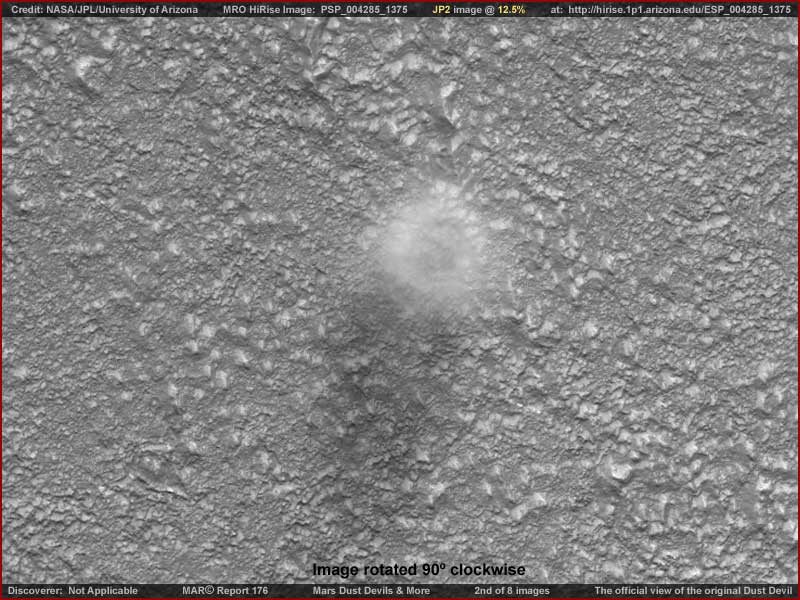
http://hirise.lpl.arizona.edu/PSP_004285_1375
The above 2nd image is the JP2 version
of the original dust devil. The evidence above is a little larger here but
shown at only 12.5% of the JP2 original size for comparison with the 1st image
scale but of course without the presence of my fake creation. I included this
JP2 distant view without any work in by me to show you the terrain around
the officially sanctioned "dust devil" since the JP2 image dust
devil is far too large to show here in a single image that could fit here
in the available report space. Even so, as you can see, there is no disturbance
of the terrain ground anywhere around this object. No disturbed ground and
no wet ground.
The only dark area is the supposed diffuse shadow consistent with the diffuse
nature of the object. If one argues that the shadow is the dark streak or
water stain, then where is the shadow of this object that is large enough,
tall enough, and strong enough to be seen in distant satellite imaging? Remember
that this is not an aerial shot a few hundred or thousands of feet above the
target as it may appear but is distant satellite imaging a great many times
further away from the target than an aerial shot.
Some may question my creation of false visual evidence? Some might surmise
that, if I can produce such a real looking fake, then what might I be doing
with other imaging at this website? That is why I always supply links to the
official imaging so that the evidence presented can be confirmed and verified
in the official data. That is also why debunkers stay away from direct confrontations
with the evidence presented at this website. They know that verification of
the evidence in the official data is always waiting in the wings.
That brings up another issue. If the above distant JP2 image scene is inadequate
proof for you, then download the 960 MB big JP2
image at the link above or those below and examine the dust devil site background
at full 100% resolution. You will find no evidence of either ground disturbance
or water presence in the closest examination. That's because the original
is also smudge treatment and not real. However, a representative sample of
what you will find in a closer examination appears in the next image below
at full resolution.
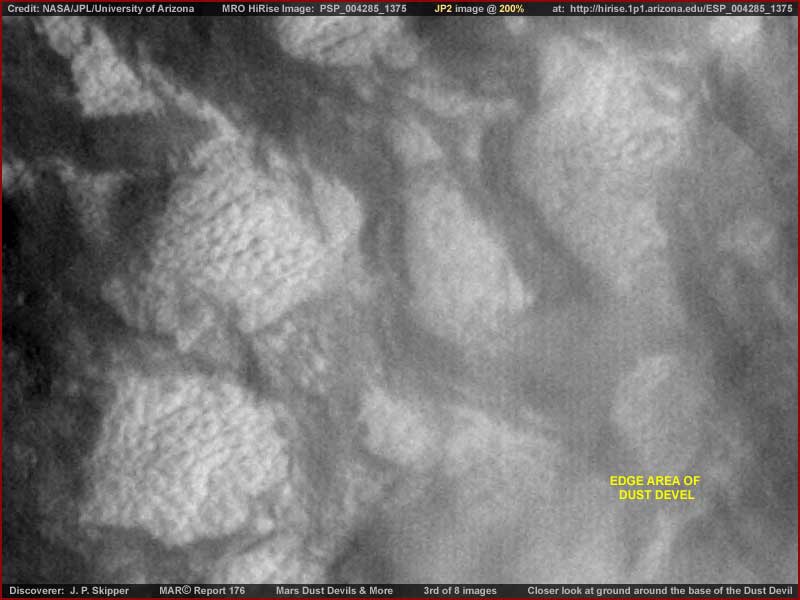
http://hirise.lpl.arizona.edu/PSP_004285_1375
The above JP2 image is of a section
of the ground at the edge and base area of the original "dust devil"
object in question. Note that we can see through the edge area of the "dust
devil" and poorly but adequately detect the ground below. One reason
is because we are not looking through sunlight reflectivity off of dust or
soil or water either for that matter but just seeing this through semi-transparent
smudge treatments.
The point is that the ground under the "object" is detectable and
soil disturbance or water presence are conspicuous by their absence. Doesn't
look much like the kind of terrain that would feed dust and soil into an air
vortex creating so much sunlight reflectivity now does it. In fact the blurry
dark areas we can see fairly well look suspiciously like some kind of very
poorly seen organic living growth material. Record that concept in your noggin
because it will become more and more important as you proceed here.
In fact, when one expands one's search out over the rest of this JP2 image
strip and at full 100% or more resolution, this impression becomes stronger
and stronger. You will see this in the next 4th–8th images below. Like
the birdie dangled in front of a child as misdirection to get the child's
attention focused toward the camera for the photo, could it be that the object
officially identified as a "dust devil" is a fake placed in this
strip to attract and focus attention away from the background terrain? Perhaps
a little visual misdirection?
Remember it is time consuming to download the maximum JP2 file and both time
consuming and laborious to search these giant JP2 images at full resolution
in a regular size computer monitor. So it is not surprising that researchers
can quickly tire of doing this and open them only when they think there's
something special to look at and even then only look at the "dust devil"
that caught their interest. Those involved in secrecy know this and we should
not be surprised that they try to capitalize on it. It is what they do.
Why do this you say? Because the other evidence in this image strip is very
large and encompasses the entire big strip. That means that, in order to adequately
obscure it, the resolution would have to cut so drastically that such a degree
of interference in the image would be quickly detectable even by scientists,
so depending entirely on that type of obfuscation alone is out. Also, the
standard smudge treatments would have to be so extensive and massive that
their presence would also be detectable by even the clueless and that's out.
So what does one do to obfuscate such huge size and extensive evidence reasonably
effectively? While cutting resolution as much as is safe to blur details,
one adds very obvious but false information into the image misdirecting attention
to that and hopefully the background will be ignored and certainly not examined
closer. However, when this misdirection doesn't work fully, the following
images and their information is what comes through to us in spite of the attempt
misdirect away from it.
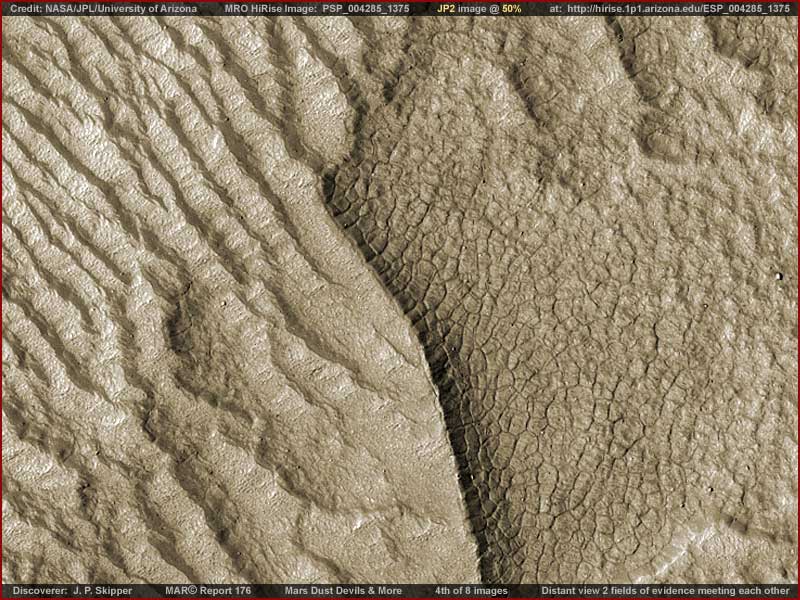
http://hirise.lpl.arizona.edu/PSP_004285_1375
The above 4th image is a JP2 image
at 50% resolution. It has a little clarification and blanketing color work
in it by me to bring out as much detail as possible. It demonstrates two different
and distinct fields of evidence meeting at a sharply defined boundary with
each other. The directional parallel evidence on the left appears to be original
formations in this terrain and the evidence on the right appears to be a newer
more recent invading type.
In real life, the two different fields probably are of different colors and
not true to what you see with my artificial coloring. That visual color distinction
would quickly identify them as organic material rather than inanimate rock
and soil geology. That is why you almost never see true color images even
though the cameras are capable of it and why you see only black and white
or at best broad expanse false color images like mine here.
Too many of you this may just look like strange looking terrain but still
terrain equating to rock and soil geology. However, if just terrain, how might
you explain it?
Okay you would likely start with the easiest and that would be the directional
evidence on the left. At first glance it looks similar to eroded land forms
on a down slope. However, if so, look at the darker evidence in the erosion
channels closer. It isn't shadow as would be the case with erosion canyons
but some feathery substance that looks like growth of some kind the same as
that under the "dust devil." Note also how uniformly dimpled the
light color surfaces on the formations are in some kind of repeat pattern.
Repeat patterns are more of a characteristic of life reproducing itself than
of erosion geology.
As for the sectional evidence on the right, that may resemble once wet now
dried terrain like the dried mud of an lake bed with its cracked surface.
However, look closer. Note how these patterns roll over and down the slope
into shadow at the boundary line between the two large fields of evidence.
This evidence along this short slope is not characteristic of geological condition
but is consistent with lichen type growth covering underlying geological surfaces
unseen here.
In fact, note that both left and right fields above tend to be light absorbing
rather than light reflective even though the sunlight here is very strong.
Bare rock and soil geology would normally be much more light reflective. It
is subtle but these are all clues as to what we are likely looking at here
and it isn't bare rock and soil geology. Note also the absence of any real
shadows and that's yet another clue.
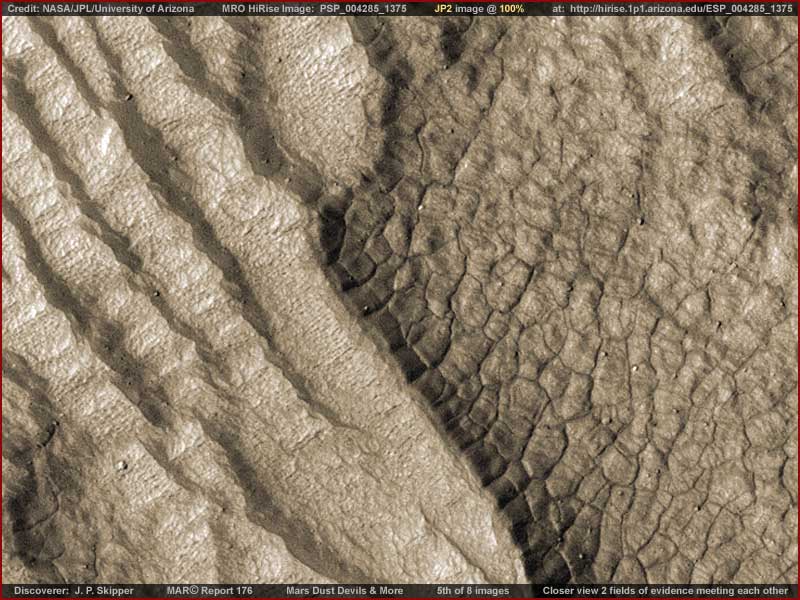
http://hirise.lpl.arizona.edu/PSP_004285_1375
The above 5th image provides a closer
view of a portion of the 4th image scene with the directional row evidence
on the left and the sectional evidence on the right. Again note that the darkness
between the directional type parallel formations on the left is not dark shadow
but something else that may be some kind of feathery fluffy growth.
It is in fact the same dark feathery looking evidence visible but blurry in
the 3rd image at the base area of the so called dust devil. Also note the
consistent uniform pattern of dimpling on the surfaces of the directional
evidence. Again this kind of repeating pattern is more consistent with life
than inanimate geology.
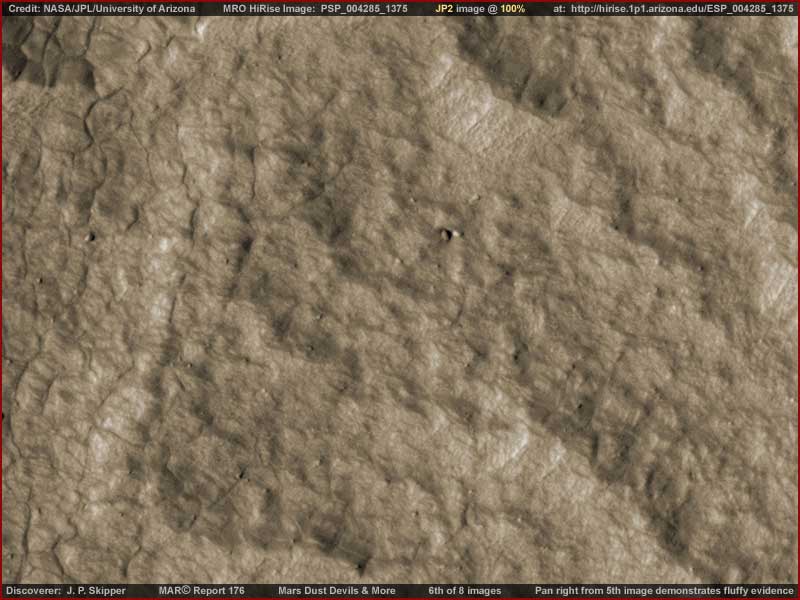
http://hirise.lpl.arizona.edu/PSP_004285_1375
The above 6th image is of a nearby
terrain location panning to the right of the 5th image scene and over into
the primarily sectional evidence covered terrain. Note how the sectional evidence
along the left side of the image transforms visually as the eye moves to the
right in the image. See how it begins to look in the transition more like
matted fur on an animal. Notice in the top area of the image just slightly
right of center the lighter color dimpled surface that is partially exposed
peaking through the mat evidence suggesting that this is the type of evidence
that is under the mat.
This is a reoccurring theme with this evidence. It seems that the lighter
color dimpled surface directional evidence occupied this terrain first and
dominated but now the sectional evidence is invading and making massive inroads
into it and its territory. Even though the sectional evidence looks so tight
and compact in the 4th and 5th images to the right of the boundary, the feathery
furry looking evidence in the above 6th image is in my opinion the same sectional
evidence just with a different look.
I'm satisfied that the sectional evidence, either in the tight compact sectional
look at the boundary or the soft feathery look further to the right, is almost
certainly colony life of some kind invading and covering over the lighter
color directional evidence in its parallel formations. I suspect that the
mat looking evidence is actually the sectional evidence in a more aggressive
configuration. In this feathery mat configuration, it invades up in the canyons
between the directional formations as well as finishing covering over large
areas of the directional evidence as you see above.
Of course I could be wrong. The directional evidence could just be land form
geology eroded by unique Mars conditions and chemistry forming the uniform
dimpled surfaces. What works against that consideration is the fact that the
directional evidence has that uniform dimpled surface that is very repetitively
uniform and over many broad surface areas in varying ground conditions from
slopes to lowlands in this big image strip.
Where ever it is at life tends to replicate itself over and over again according
to its genetic coding while the look of geology is the result of many random
events occurring in its environment impacting and shaping it. That works against
repetitive uniformity from one different location site type to another. Further,
even if the directional evidence is geology, there is still the sectional
evidence and its aggressive growth stage and behavior that I am more than
satisfied is life.
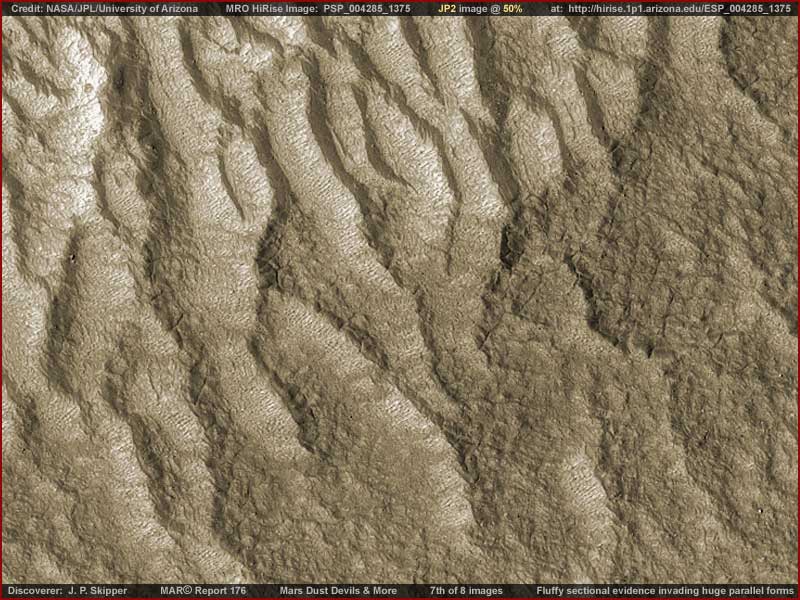
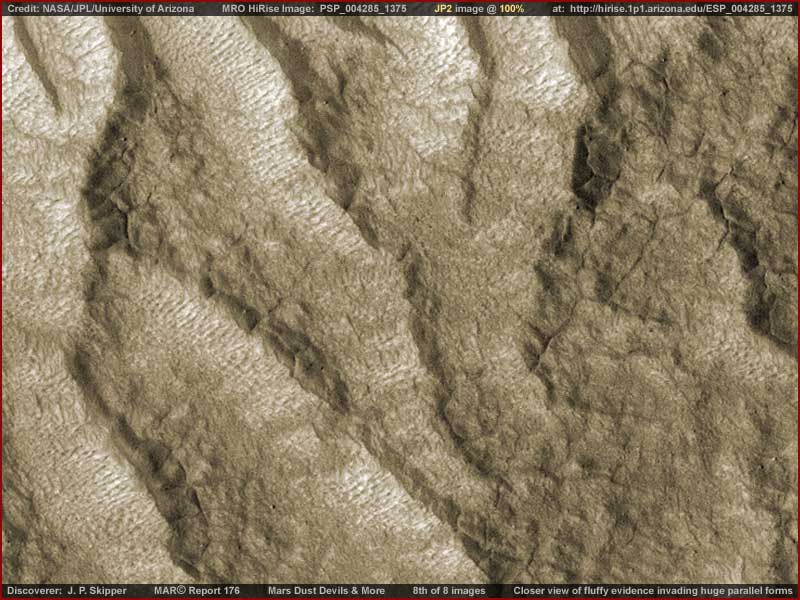
http://hirise.lpl.arizona.edu/PSP_004285_1375
The above 7th and 8th images are of
a different location in the lower left of the JP2 strip with the 7th image
being a wider context view and 8th image providing a closer look of a section
of the 7th image. Once again the same type of evidence is demonstrated with
the same type of invasion situation but in a different location in the strip.
As with the 4th and 5th images, I chose this second location because it again
demonstrates a transition point from one type of evidence to another. Above
this point of view is extensive directional evidence and below it is more
pronounced sectional evidence. Further, if you will look very closely, you'll
be able to see that the feathery mat look in these two images is wanting to
form into the tighter sectional evidence look but just can't quite make it
demonstrating that they are one and the same.
Another observation that I'll make here is that, even though the directional
evidence terrain is still being invaded by the sectional evidence in the canyons
between the forms, the directional evidence above this point seems to operate
better and be more free of the sectional evidence when an upward slope becomes
more pronounced. The further up slope one moves in these presented scenes,
the more free the directional evidence is of this invasive sectional material.
Note that in these images the sectional evidence seems to make its first inroads
into the field of directional evidence by moving up in canyons between the
parallel directional formations and spreading out over the formations from
these positions along the sides. This in turn suggests that there is a crack
or valley between the directional formations that the sectional evidence is
invading and filling. That in turn may suggest that there may be some water
presence on the slopes and the sectional evidence is taking advantage of its
more available presence in these valleys between the huge directional formations.
This in turn suggests that the sectional evidence does better in the lower
terrain levels where moisture, if any is present at all, could be anticipated
to be a bit more plentiful collecting at the base area of slopes. An investigation
of the lower level terrain in the JP2 image confirms that this is true and
that the sectional evidence is more prevalent there. However, even where the
sectional evidence dominates, it seems to be doing so on top of the directional
evidence and that suggests that the directional evidence was in times past
first here in this place and dominated.
The fact that the directional evidence also has a massive presence in the
lowlands being covered by the sectional evidence as well as on the slopes
suggests that it is some kind of massive life form unique to Mars rather than
being just eroded geological land forms on slopes. I mention this because
it may be easy for some to dismiss the directional evidence in just a quick
superficial examination as eroded land forms when one now sees it visible
primarily on the terrain slopes .
So, as you look closer at the terrain evidence that serves as a background
for the "dust devil" evidence, it begins to become more evident
that this type of more level terrain is just not really conducive to feeding
surface soil or dust into a dust devil that is so strong and big that it can
be easily seen in this distant resolution compromised satellite imaging and
would easily qualify as a big tornado. Yet it leaves no signs of disturbance
of its passing on the ground.
For most researchers the presence of a officially sanctioned "dust devil"
like this one is a misdirection distraction bending attention away from the
image background. For the more suspicious researcher, its presence is a red
flag signaling the researcher to look closer at the obvious object and then
fan out over the rest of the image with a more objective view.
It is the difference between the comfort of the consensus building herding
instinct and a maverick presence trying to think outside the box. You must
decide for yourself which is the more productive approach as well as who may
be full of it and who isn't.
, Investigator
![]()